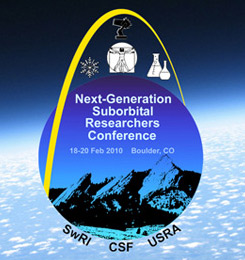 I recently attended a conference in Boulder, and I have to admit that before I went I wasn’t sure what to make of it. Now I do, and I’m very glad I went.
I recently attended a conference in Boulder, and I have to admit that before I went I wasn’t sure what to make of it. Now I do, and I’m very glad I went.
The meeting was the Next-Generation Suborbital Researchers Conference 2010 (NSRC2010), and its goal was to figure out how best to exploit an upcoming revolution in space travel: private companies making suborbital launches to the very edge of space.
Space, in this case, is defined as being 100 km (62 miles) above the Earth’s surface. There, the atmosphere is incredibly thin, which has obvious benefits for astronomical observations (less turbulence blurring images, darker skies to see faint objects, less air to absorb ultraviolet and infrared light). But perhaps just as importantly, the planned flights will have up to three full minutes of microgravity – what is popularly but inaccurately called weightlessness or “zero g”.
That’s where my initial skepticism came in. What can you do with only a few minutes of free fall? Well, it turns out you can do a lot. There are a host of biological, engineering, and astronomical experiments that can be run in this environment, ones that would be far too prohibitively expensive to do on, for example, a Shuttle mission.
But this next generation of rockets from Virgin Galactic (Richard Branson’s effort with Space Ship 2, a model of which is pictured above), Blue Origin (Jeff Bezos from Amazon.com), and others will reach a height making a lot of this science possible. The region up to 100 km is too high to reach by balloon, and too low for orbital rockets, which is why it’s been dubbed “the ignorosphere”. But it has its uses…
Observations of the Sun, for example, may not need much time to do because (you may have noticed) the Sun is pretty bright, so a three or four minute flight is enough to get some good data. The way incoming energy from the Sun couples with the Earth’s atmosphere is not hugely well understood, and a lot of it happens in this region high above the planet’s surface. Effects of low gravity on the human body can be tested, as well as on plants and other biological systems.
In fact, enough science can be done on these trips that the conference itself brought in 250 people interested in the topic. I was surprised at how many people came, as were the conference planners themselves: they were expecting half that many.
But there’s a lot of confidence here. Lori Garver, NASA Deputy Administrator, gave a keynote talk, saying that NASA will pledge $15 million per year to this new field of research in the new budget (pending approval by Congress). Alan Stern, an astronomer and conference organizer, announced that Southwest Research Institute, for whom he works, will put up $1 million of its own money for researchers to fly into space, too!
Given that each flight will cost something like $200,000, this is a pretty decent pool of money to investigate the ignorosphere. That may sound like a lot, but in fact a lot of scientific grants are in this range; a few years back I had my own personal research grant on Hubble that was for more than $40,000, and while I was at Sonoma State University our small team routinely applied for educational grants for $50k and more. Getting $200k for a flight is well within the reach of a lot of researchers. Of course, they’ll need more to cover equipment and such, but compare that to the millions upon millions needed for an orbital flight, or even several million for a sounding rocket, and you start to see that this is a pretty good deal.
NASA itself can use this sort of thing as well, testing equipment and new technology to see how it behaves. This is a whole lot cheaper than putting something up on the Space Shuttle (or on the next generation of orbital rockets).
It was exciting to sit and listen to all the buzz about this new, intermediate frontier. But as interesting as the science was, there was something more important going on at this conference. Something that, I suspect very strongly, will change the way we look at space travel.
And that will be the topic of my next post on this. Stay tuned.